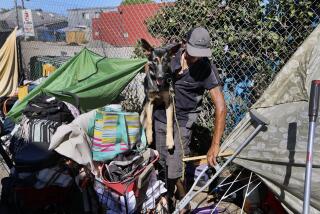Homeless youth bring bold, confrontational approach to Santa Clarita
The rumpled young men were sleeping on the ground outside the coffee shop as early morning patrons made their way in. They routinely hogged the store’s bathroom, and often left it stinking and littered with the residue of narcotic use. At the market nearby they’d cruise the aisles, buoyed by drug-fueled belligerence, intent on shoplifting.
When they were done — or after the sheriff had been called — they’d disappear into the brush behind the shopping center in Santa Clarita and head toward the Santa Clara riverbed.
I heard the stories from worried customers and frustrated residents of the upscale neighborhood. Some had lived in the area for years and learned to co-exist with hippie types who liked living off the grid.
But these were mouthy guys with iPhones, lots of tattoos and more than a hint of menace in their attitudes.
Crude encampments have come and gone for years in this once-rural niche of Los Angeles County. But that rustic version of homelessness has given way to something less benign and more in-your-face. The transients who bed down now amid the boulders and brush seem to be younger, bolder and more aggressive.
They’re small in number, but a potent reminder that the squeaky-clean city of Santa Clarita — which once tried to ship transients to Los Angeles — has a home-grown homeless problem that’s becoming more obvious and harder to manage.
“We’re getting more complaints,” said Tim Davis, executive director of Bridge to Home, which runs the city’s only homeless shelter. “I’ve been here for 26 years; it hasn’t been this visible before. I don’t know if there are more people or there’s just a new style of hanging out.”
That new style, locals told me, includes conducting drug deals in daylight outside an upscale apartment complex and threatening people who dare to object.
Some residents feel afraid, others merely insulted. It’s an affront to suburban sensibilities in a town known for family-friendly tranquillity.
::
I spent Sunday tramping through brush and along dirt trails looking for those bands of roguish youths who are putting a pox on paradise. I passed packs of middle-aged men pedaling by in colorful biking gear; I chatted with hiking families. The only sign of a homeless encampment I found was a debris-strewn patch amid a clump of trees near the dry riverbed.
Davis wasn’t surprised; many camps are small and well-disguised. “These people are doing their best to keep a low profile,” he said. Once a site is discovered, they tend to pack up and move on — leaving empty bottles, dirty clothes and drug paraphernalia behind.
Davis took a team of counselors, deputies and city officials out last fall to survey people living in the wash and found about 20 encampments. He’s trying to recruit volunteers this week to conduct an official tally that may lead to more funding for social services.
“Santa Clarita is wealthy and pretty and has great parks and walkways,” he said. “But we also have family issues and drug problems and alcoholism and housing that people can’t afford.”
Los Angeles County Sheriff’s Deputy Dan Dantice has been on those forays with Davis as part of the region’s crime prevention campaign. He sees the problem from a different perspective: “Many of them are drug addicts, and there’s definitely a crime element that comes with that sort of lifestyle.”
They’ve gotten bolder, he said, because they are no longer concerned with accountability — thanks to Prop. 47, the voter-approved initiative that made California the only state in the nation where possession of heroin, cocaine or methamphetamine is a misdemeanor, not a felony.
“If they get arrested for heroin possession or meth, they’re booked and out in a few hours,” he said. Penalties were also reduced for shoplifting, so if they’re caught stealing to support their drug habits, it’s treated with the seriousness of a traffic ticket.
“It’s frustrating for us as well as for the residents and businesses,” the deputy said. “We’re trying to come up with little things you hope will discourage them, because they’re not afraid of being arrested anymore.”
::
Part of the problem, Dantice said, is soft-hearted residents. “People in Santa Clarita are very generous,” he said. “When they see somebody on the corner asking for money, they want to help them.”
George McGuinness is one of those kind-hearted types. He contributes to his church, where the local homeless shelter is one of three charity projects, along with an orphanage in Honduras and an Ebola clinic in Sierra Leone. “We’re trying to raise enough money to keep our shelter open all year,” he said. Now, it only operates from November to March.
I met him on Sunday in the parking lot of the shopping center where the homeless youths tend to gather. He pointed out an empty spot in the brush recently vacated by a homeless couple. “You feel sorry for the kids,” he said. He thinks some are runaways who’d like to go back home.
But McGuinness admits to a bit of compassion fatigue.
He’s had to stop young transients from urinating against the wall of a grocery store that backs up to a nature trail. “That’s not the kind of thing you want to see when you’re jogging or riding bikes with your kids,” he said.
He volunteers with a clean-up campaign that keeps the area near the wash free of graffiti and trash. While picking up debris near a bench where a homeless man had slept, he found a package of crystal meth. “Can you imagine if a child had found that,” he said.
He’s tried to help the weathered blond woman, who panhandles with her three dogs near the entrance to the shopping complex. “She had a Nazi symbol tattoo,” he said, shaking his head. “That bothered me a lot. But it was cold and she was barefoot, so I gave her shoes,” he said.
The next day she was back to begging, shoeless again.
Twitter: @SandyBanksLAT
More to Read
Sign up for Essential California
The most important California stories and recommendations in your inbox every morning.
You may occasionally receive promotional content from the Los Angeles Times.











